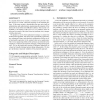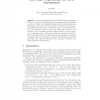142 search results - page 8 / 29 » Program obfuscation: a quantitative approach |
SP
2010
IEEE
13 years 11 months ago
2010
IEEE
—To handle the growing flood of malware, security vendors and analysts rely on tools that automatically identify and analyze malicious code. Current systems for automated malwar...
SAC
2009
ACM
14 years 2 months ago
2009
ACM
In a typical client-server scenario, a trusted server provides valuable services to a client, which runs remotely on an untrusted platform. Of the many security vulnerabilities th...
PLDI
2009
ACM
14 years 8 months ago
2009
ACM
As computer systems continue to become more powerful and comdo programs. High-level abstractions introduced to deal with complexity in large programs, while simplifying human reas...
TACAS
2012
Springer
12 years 3 months ago
2012
Springer
The number of malware is growing extraordinarily fast. Therefore, it is important to have efficient malware detectors. Malware writers try to obfuscate their code by different tec...
RR
2009
Springer
14 years 2 months ago
2009
Springer
Our previous work [26] introduced Belief Logic Programming (BLP), a novel form of quantitative logic programming with correlation of evidence. Unlike other quantitative approaches ...


